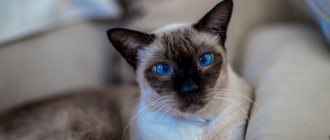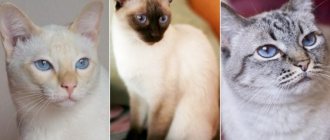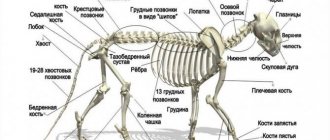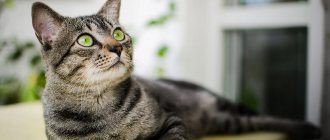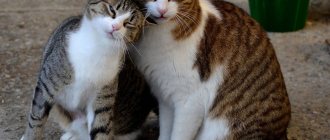Thai and Siamese cats have a common ancestor, the same homeland, and significant external similarities. It is not surprising that many consider them representatives of the same breed. This misconception is especially widespread in the CIS countries, where all cats with a dark face, light body and blue eyes are called Siamese, although they are often representatives of the Thai breed. Let's look at the similarities and differences between Siamese and Thai cats.
History of the origin of breeds
The ancestor of both breeds appeared in Siam in the 14th century. Back then, a cat with an unusual appearance was considered sacred. Local residents were in no hurry to sell the animal to foreigners. That is why the breed came to Europe and America only at the end of the 19th century. European and American breeders put a lot of effort into creating a new breed based on the exported cats, which was later officially called the Siamese.
In ancient times, Siamese cats lived at the temples and chambers of the ruling family. Animals were protected from strangers. For kidnapping and attempting to take out a cat, the daredevil could pay with his life.
As a result of selection, the Siamese cat began to differ significantly in appearance from its ancestors. Fans of traditional Siamese decided to work on creating a new breed that is more similar to their ancestors. For selection, animals were used that were preserved in Thailand (Siam received this name in the middle of the 20th century). In 1991, the breed was officially recognized. Since the name “Siamese cat” was already taken, the breed was called Thai.
Mixed cats
Despite the fact that kittens from representatives of various breeds can be bright, graceful and funny, mixed breeds will never become the owners of a pedigree and will not take first places at exhibitions.
Mixed-breed cat - what is it? The answer to this question is known to every breeder, who mercilessly cull kittens born from different breeds. But many modern breeds appeared through random crossing. This is how the Broomilla breed arose from a Persian father and a Bruma mother. The first offspring was not considered a breed, but thanks to the work of the breeder, who continued to work on improving the new species, the Broomilla was recognized and included in the International Register of Pedigree Cats.
Similarities
Although the difference between a Siamese and a Thai cat is visible at first glance, the breeds are often confused due to the same color and similar characters.
Appearance
Common features of the appearance of Siamese and Thai cats:
- Blue eye color, which is rare among other breeds.
- Short and smooth coat. It is very pleasant to the touch. Often the coat of Thais is slightly longer than that of Siamese. There is practically no undercoat.
- Color point color: dark mask on the face, dark ears, dark paws and tail. The main coat color is light.
Similarities in character
Both breeds are devoted to their owner. They may be wary of strangers. They have high intelligence. Thai and Siamese cats can be taught to perform different tricks. Both breeds are quite jealous towards other pets. They are also very energetic and active. They love to play and run around the house.
Personality of the Thai cat
Thai cats are calm and balanced. But at the same time, because of her great love for her owner, such a kitty is jealous and will not give other animals a quiet life in the same house as her. For a Thai kitten, loneliness and sudden changes in surroundings are unbearable; its psyche may suffer.
The main advantages of the Thai cat are that it is smart and affectionate. If you spend enough time with your pets, training and caring for them, they will respond with great love and devotion.
The characteristics of the Thai cat are its curiosity and activity. They look at what they see for the first time with great attention and enjoy playing with toys and making a mess in the house.
Differences
If you put two representatives of the breed side by side, their differences will immediately become visible. Siamese cats in appearance are more like an oriental breed, while Thai cats in body structure are almost no different from the street cats we are used to.
Appearance
The differences between the Thai cat breed and the Siamese begin with size. Thais are larger and more powerful. They can weigh from 4 to 8 kg. Siamese cats seem more fragile and graceful. Their weight varies from 3 to 4 kg.
Table: Body structure of Siamese and Thai cat breeds
| Part of the body | Siamese breed | Thai breed |
| Head | Elongated wedge-shaped | Round shape |
| Ears | Large, triangular in shape, set wide apart | Medium size, rounded ends |
| Profile | Long and straight “Greek” nose. There is no transition from forehead to nose | The forehead meets the nose at a slight angle at eye level |
| Eyes | Almond-shaped, slanted, with a slight squint | Round or oval shape |
| Neck | Long and slender | Powerful and muscular, medium length |
| Torso | Elongated, slender, long | Large, wide, muscular |
| Limbs | Long and slender. The paws are small and neat | Middle length |
| Tail | Long and thin | Wide, medium length |
Similarities in character
Differences between the Siamese cat and the Thai cat can also be seen in the character traits of the breeds. It is believed that Siamese have a heavier character. If raised incorrectly, they can turn into quite aggressive and uncontrollable animals. In addition, they are capable of making a large number of loud sounds. Siamese should be allowed near children with caution. This breed is not shy about using its claws if it is offended. Siamese cats are also vindictive and vindictive. At the same time, they are very devoted to their owner, whom they will follow with their tail, and to whom they will give all their love.
Thai cats are softer and more peaceful. They are gentle with children and get along more easily with other pets. Unlike Siamese, Thais can more easily tolerate long-term separation from their owner. They do not need constant attention and can easily find something to do on their own.
It should be noted that the character of a pet depends not so much on the breed, but on the individual characteristics of each animal and upbringing. Therefore, some Siamese cats may well be peace-loving, while Thai cats may be harmful and vindictive.
Choosing a mixed-breed cat
Every cat is unique. But experts believe that by external signs - the shape of the skull, body structure, color and length of fur - it is possible to predict the character traits of a pet from a very young age. And even a predisposition to disease. Mixed breeds of elite cats inherit from their parents the appearance and behavior pattern characteristic of a particular breed. When choosing a mestizo, you should pay attention to the main phenotypes. Try to determine from them what character the cat will have and its future health problems.
"Marquise" phenotype
Short, black fur with white spots. The body constitution of cats is dense, while that of cats is thin. This phenotype is characteristic of short-haired European breeds. These pets have a stable, predictable character. They demonstrate their desires quite clearly. They try to manage the house and achieve their goal with affection or perseverance. They have good health. With poor nutrition, urolithiasis can develop.
Phenotype "Siberian cat"
The color is gray-striped. The coat is long with a thick undercoat. The body is loose or dense. The head is large, round, with a protruding muzzle. Confident, independent character. These animals are “on their own.” They skillfully put the owners in the desired place and show who is boss in the house. Affections are accepted solely of one's own free will.
They don't like it when they are bothered with attention. May experience digestive problems
Suffer from obesity, diabetes, urolithiasis,
Angora cat phenotype
Long or semi-long light coat. Dry, tender body. Elegant, light head. Having an independent disposition, they show miracles of devotion and trust in the owner. Sensing the weakness of the owner, they can show “savagery” and aggressiveness, defending themselves and protecting the territory. They need daily human contact. The owner is expected to be predictable and stable. Health is good. Problems with respiratory function and infections are possible.
"British" phenotype
The coat is dense and short. The head is round, large, with erect ears. The body structure is rough and dense. Tabby and blue-gray color. The tail is thick, with transverse stripes. Independent character. Showing displeasure, they can be stubborn and aggressive. These cats are not easy to handle. Touching is allowed, guided solely by one’s own mood. They often become “masters of masters.” Like all cats with a rough constitution, they have a tendency to chronic kidney diseases and obesity. And also, endocrine system disorders and chronic pancreatitis.
Phenotype "Persian cat"
The coat is long, silky, without coarse guard hairs. The head is round, the nose is flattened. The body constitution is rough or loose. They have an independent character and position themselves as a decoration for the home. They can be capricious and demanding. Persians and mestizos are often cut like a lion. Since long hair needs to be combed, and Persians do not like this procedure. Predisposed to diseases of the genitourinary system and upper respiratory tract.
Phenotype "oriental cat"
A cat with short, delicate fur. Thin, dense skeleton with developed muscles. The body is elongated. Quite heavy with an elegant appearance. Light, graceful head. Large or medium movable ears. The color is varied: spotted, solid, striped, color-point, tabby and others. Due to their focus on the owner and the need for constant communication, they are called “cat-dogs”. Orientals have irrepressible energy. Need active games. If energy is not used, obesity may begin. They strive to restore order in the house. Health is quite good. They may have digestive problems and infections.
Phenotype "Thai cat"
Semi-long or short coat of characteristic colors: blue point, seal point, lilac tabby point, lilac point. The head is round. Eye color is blue. Strong, graceful cats with a dense, but not coarse constitution. The character is even, non-conflicting. The behavior model is close to that of a dog. They need constant contact with the owner. They are acutely aware of his mood swings. Empathizing with the problems of the owners, they can get sick. They are very persistent in achieving their goals. They achieve their goals not through arrogance and aggression, but through persistence and affection. Health is quite good, but they are susceptible to urolithiasis and slow infections.
Taking into account the external signs of the pet, it is possible to predict the future character and behavioral model. Take measures for proper education and prevent possible diseases.
Health and life expectancy
The Siamese and Thai breeds are distinguished by good health and long life expectancy. Thai cats live 10-14 years, but it is not uncommon for them to live up to 20 years with good care. Siamese cats live 13-18 years.
The Guinness Book of Records records a Siamese cat that lived to be 38 years old.
Diseases to which representatives of breeds are predisposed
| Siamese cat | Thai cat |
| Congenital strabismus | Hip dysplasia |
| Glaucoma | Urolithiasis disease |
| Heart failure | Arthritis |
| Amyloidosis of the liver and kidneys | Diseases of the reproductive system |
Choosing the gender of the kitten
Siamese cats and cats are well trained in the intricacies of going to the litter box and other rules. But they spend more effort on “training” their owner so that he unquestioningly fulfills all the wishes of the pet. Pets of this breed are great manipulators and their impressive loud voice, produced with different intonations, helps them in this.
The Siamese male has excellent patience and gets along well with children. Long hugs are alien to him, but a kitten of this breed will not refuse to play. Cats are also friendly towards other animals, even dogs. The Siamese cat has a smart look and a good character. And the variety of colors, the sophistication of color and manners, the radiating sense of self-esteem, combined with a simple and calm temperament, make him an ideal cat.
Although the male Siamese cat is a large and strong animal, he is not able to fend for himself on the street. For this reason, you should not let him walk on his own. An animal can also become infected with the disease from outdoor cats.


